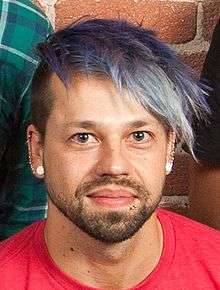Josiah Zayner
| Josiah Zayner | |
|---|---|
 Zayner, 2014 | |
| Born | February 8, 1981 |
| Occupation | Biological scientist |
Josiah Zayner is a biohacker and scientist best known for his crowdfunded campaign to provide genetic engineering CRISPR kits to the general public.
Career
Zayner graduated from the University of Chicago with a Ph.D. in biophysics in 2013. He then spent two years as a researcher at NASA's Ames Research Center,[1] where he worked on Martian colony habitat design. While at the agency, Zayner also analyzed speech patterns in online chat, Twitter, and books, and found that language on Twitter and online chat is closer to how people talk than to how they write.[2] Zayner found NASA's scientific work less innovative than he expected, and upon leaving in January 2016, he launched a crowdfunding campaign to provide CRISPR kits to let the general public experiment with editing bacterial DNA. He also continued his grad school business, The ODIN, which sells kits to let the general public experiment at home. As of May 2016, The ODIN had four employees and operated out of Zayner's garage.[1]

He refers to himself as a biohacker and believes in the importance of letting the general public participate in scientific experimentation, rather than leaving it segregated to labs.[1][3][4] Zayner found the biohacking community to be exclusive and hierarchical, particularly in the types of people who decide what is "safe". He hopes that his projects can let even more people experiment in their homes. Other scientists have responded that biohacking is inherently exclusive for its dependence on leisure time and money, and that deviance from general safety rules could lead to even harsher regulations for all.[5] Zayner's public CRISPR kit campaign coincided with wider public scrutiny over genetic modification. Zayner maintained that these fears were based on misunderstandings of the product, as genetic experiments on yeast and bacteria cannot produce a viral epidemic.[6][7] In April 2015, Zayner ran a hoax on Craigslist to raise awareness about the future potential of forgery in forensic genetic testing.[8] Zayner later used CRISPR to attempt to edit his own genes and is the first known person to do so.[9][10]
In February 2016, Zayner attempted a full body microbiome transplant on himself, including a fecal transplant, to experiment with microbiome engineering and to see if he could treat his gastrointestinal and other health issues. The microbiome from the donor's feces successfully transplanted in Zayner's gut according to DNA sequencing done on samples.[1] This experiment was documented by filmmakers Kate McLean and Mario Furloni and turned into the short documentary film Gut Hack.[11]
In December 2016, Zayner created a fluorescent beer by engineering yeast to contain the green fluorescent protein from jellyfish. Zayner's company, The ODIN, released kits to allow people to create their own engineered fluorescent yeast, which was met with some controversy as the FDA declared that the green fluorescent protein can be seen as a color additive.[12] Zayner, views the kit as a way that an individual can use genetic engineering to create new things in their everyday life.[13]
In the arts, Zayner created a musical instrument, the Chromochord, which stimulates light-, oxygen-, and voltage-sensing proteins and translates their reactions into music.[14][15] In 2014, he worked with the new media artist Lynn Hershman Leeson to create an art installation about genetic engineering, which included a booth designed by Zayner that attempted to reverse engineer a person's DNA from their picture. The installation was shown at ZKM and Deichtorhallen.[16]
References
- 1 2 3 4 Duhaime-Ross, Arielle (May 4, 2016). "A Bitter Pill". The Verge. Retrieved June 14, 2016.
- ↑ Bennett, Drake (March 14, 2014). "Twitter Is Just Like Talking, Only More Narcissistic". Bloomberg.com. Retrieved June 14, 2016.
- ↑ Chicago Tribune (January 29, 2016). "Biologist's gene-editing kit lets DIYers play God at kitchen table". chicagotribune.com.
- ↑ Denver Nicks. "DIY Gene Editing Kit Sold for $120 by Josiah Zayner, Scientist". MONEY.com.
- ↑ Yin, Steph (May 3, 2016). "Is DIY Kitchen CRISPR A Class Issue?". Popular Science. Retrieved June 14, 2016.
- ↑ "What Happens If Someone Uses This DIY Gene Hacking Kit to Make Mutant Bacteria?". Motherboard.
- ↑ "Governance: Learn from DIY biologists". Nature News & Comment.
- ↑ "A NASA Scientist Is Behind the 'My DNA Was Planted' Viral Craigslist Ad". Motherboard.
- ↑ Pearlman, Alex (November 15, 2017). "Biohackers are using CRISPR on their DNA and we can't stop it". New Scientist. Retrieved November 16, 2017.
- ↑ Lee, Stephanie M. (October 14, 2017). "This Biohacker Is Trying To Edit His Own DNA And Wants You To Join Him". BuzzFeed. Retrieved November 16, 2017.
- ↑ "New York Times Op Docs: Gut Hack". New York Times.
- ↑ "DNA Biohackers Are Giving The FDA A Headache With Glow-In-The-Dark Booze". Buzzfeed.
- ↑ "This Biohacker Wants to Spur a Genetic Engineering Revolution With Glowing Beer". Gizmodo.
- ↑ Katie Drummond (September 5, 2013). "The world's smallest violin: scientist uses proteins to create a new musical instrument". The Verge. Vox Media.
- ↑ Nona Griffin,Daniel Grushkin. "Biotech's First Musical Instrument Plays Proteins Like Piano Keys [Slide Show]". Scientific American.
- ↑ B. Ruby Rich (Spring 2015). "On and Off The Screen". Film Quarterly.
Further reading
- Ireland, Tom (December 24, 2017). "'I want to help humans genetically modify themselves'". The Observer. ISSN 0029-7712.
- Krieger, Lisa M. (January 11, 2016). "Bay Area biologist's gene-editing kit lets do-it-yourselfers play God at the kitchen table". The Mercury News. Retrieved May 20, 2018.
- Zhang, Sarah (February 20, 2018). "A Biohacker Regrets Publicly Injecting Himself With CRISPR". The Atlantic. ISSN 1072-7825.